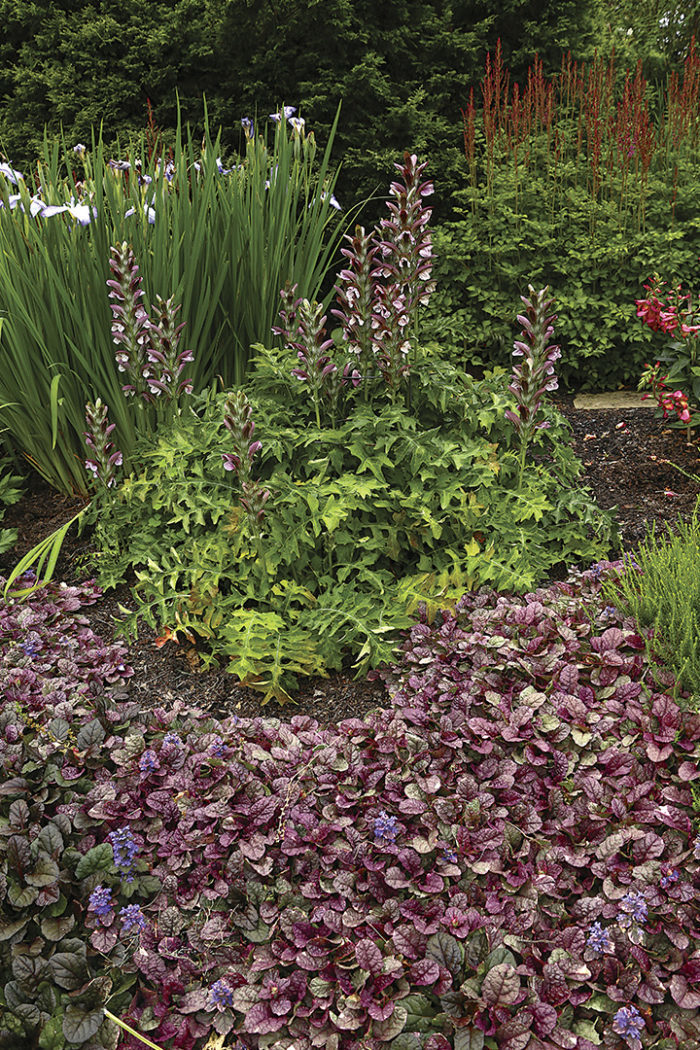
As a garden designer and nurserywoman, I am always scouting for uncommon plants that have a long season of interest and are not fussy to care for. I like plants that have a bloom period of 6 weeks or more or have attractive foliage for much of the growing season—or both. If the plants are deer resistant and attract pollinators and butterflies, they score even higher on my list.The following are some of the exceptional, underutilized plants that I think more gardeners should know and grow. Perhaps its time to make room in your garden for one or more of these laid-back beauties.
Hungarian Bear’s Breeches is Boldly Architectural
Acanthus hungaricus
Hungarian bear’s breeches is hardier for me than its better-known relative, Acanthus mollis (Zones 7-10). This selection has thrived for 20 years near our stone wall in a spot with full sun and very well-drained soil. In early summer, its stunning, 3-foot spires of two-toned white and lavender flowers emerge and carry on blooming into August. Big, bold Acanthus foliage is said to have been the inspiration for the designs on classical Corinthian columns. Plants will spread where happy, and I have found the leaves to be a perfect foil for dying bulb foliage.
Zones: 5-10
Size: 3 to 4 feet tall and 2 to 3 feet wide
Conditions: Full sun; tolerates a range of well-drained soil types
Grow ‘Daphnis’ Peuce Masterwort for its Refined Foliage
Peucedanum ostruthium ‘Daphnis’

Upon first glance, you might misidentify ‘Daphnis’ peuce masterwort as a particularly refined bishop’s weed (Aegopodium podagraria*, Zones 4-9). But upon further study, you will notice that the foliage is larger and has more substance, with attractive, creamy yellow to white leaf-edge variegation. In early summer, graceful stems bear white umbels resembling Queen Anne’s lace. I always cut back the flowers to encourage new foliage growth. Though this plant spreads by rhizomes, I would not call it invasive.
Zones: 5-9
Size: 15 to 20 inches tall and wide
Conditions: Full to partial shade; average to moist soil
Wall Germander Can be Either Formal or Relaxed
Teucrium chamaedrys and cvs.

Wall germander is a tidy evergreen with lavender-pink midsummer flowers favored by all the best insects and butterflies. Best known for its use in knot gardens, germander is one of my go-to plants for spaces that are sunny and on the dry side. Plants can be kept clipped for a tidy look or allowed to relax a bit. Every few years, it benefits from being sheared back after its blooms fade.
Zones: 5-9
Size: 18 to 24 inches tall and 9 to 12 inches wide
Conditions: Full sun; average to dry, well-drained soil
Use Variegated Five-Leaf Aralia to Brighten Dry Shade
Eleutherococcus sieboldianus (syn. Acanthopanax sieboldianus) ‘Variegatus’
As a nurserywoman, I cringe a little when plant names change. New gardeners become confused, and longtime gardeners have trouble finding the plant. If you can get past pronouncing this plant’s botanical name, you will discover that variegated five-leaf aralia is one tough shrub for almost any situation: average to dry soil; from full sun to deep shade. It has showy, white-edged palmate leaves on arching branches that can brighten a shady corner like no other. There are flowers in the spring, but they are inconspicuous. Do note that this plant has thorns, which help to deter unwelcome creatures like deer. This plant can grow to its full size rather quickly.
Zones: 4-9
Size: 6 to 8 feet tall and wide
Conditions: Full sun to full shade; medium to dry, well-drained soil, or evenly moist soil if planted in full sun
Korean Fairy Bells are a Magical Choice for Early Spring Interest
Disporum flavens
Easy, stunning, and underplanted, Korean fairy bells in an early spring garden always make me smile. Sturdy shoots that resemble Solomon’s seal (Polygonatum spp. and cvs., Zones 3-9) emerge in April and grow about 2 feet tall with canary-yellow pendant blossoms in small clusters at the tips. This shade-loving plant spreads slowly by rhizomes, and it may take a few years to form impressive clumps. Then count on it to be long lived and deer resistant.
Zones: 5-8
Size: 24 to 30 inches tall and 9 to 12 inches wide
Conditions: Full to partial shade; moist, organically rich, well-drained soil
‘Alexander’s Great’ Brunnera Shines in Shade
Brunnera macrophylla ‘Alexander’s Great’
Another lovely plant for shade is ‘Alexander’s Great’ brunnera. Provided with rich, well-drained soil and adequate moisture during dry spells, it grows to 11⁄2 times the size of an average brunnera. In early to midspring, wiry stems carry sprays of tiny, true-blue flowers just above the foliage. It is important to cut back flowering stems as they fade to encourage a second flush of the gorgeous, silvery, heart-shaped leaves accented with deeper green veining. I must have let a few flowers develop seed, for in recent years, I have discovered occasional variegated progeny nearby. Deer do not find brunnera delectable.
Zones: 3-8
Size: 18 to 24 inches tall and 24 to 30 inches wide
Conditions: Partial shade; moderately moist, well-drained soil
‘Paul Farges’ Clematis Produces Clouds of Flowers
Clematis ‘Paul Farges’
Most gardeners are drawn to the big-flowered clematis(Clematis spp. and cvs., Zones 4-11), which will sulk after planting until their roots are well anchored. I, for one, appreciate a clematis that doesn’t need much coddling, and ‘Paul Farges’ never asks for much. Its white blooms are 11⁄2 to 2 inches wide, resembling a larger form of sweet autumn clematis (Clematis terniflora*, Zones 4-8), except ‘Paul Farges’ blooms from June to August on both new and old wood. If you want to control its vigor, cut the plants back to 12 inches tall in spring. Or let it do its thing, and it will easily extend 15 to 20 feet. This deer-resistant vine can cover a stone wall, fence, or pergola, or scramble up a mediumsize shrub or small tree.
Zones: 5-9
Size: 15 to 20 feet tall
Conditions: Full sun to partial shade; moderately moist, fertile, well-drained soil
‘Jackman’s Blue’ Rue Attracts Butterflies and Pollinators, but Not Deer
Ruta graveolens ‘Jackman’s Blue’
Desirable and durable rue, once relegated to the herb garden, deserves a more prominent spot in the landscape. ‘Jackman’s Blue’ has a tidy growth habit, and its pretty, aromatic, blue-gray pinnate foliage provides a decidedly lacy effect. In late summer, citron-yellow flowers appear on stems just above the foliage, attracting myriad butterflies and pollinators. I notice ‘Jackman’s Blue’ featured regularly in British garden periodicals, but with its excellent cold hardiness and deer resistance, there’s no reason why we can’t use this plant more often here in the States. If you have sensitive skin, be sure to wear gloves when handling this plant; it produces an oil that can react with sunlight to cause an itchy rash on some people.
Zones: 4-9
Size: 18 to 24 inches tall and wide
Conditions: Full sun; well-drained soil
‘Blue Star’ Kalimeris is Long Blooming and Drought Tolerant
Kalimeris incisa ‘Blue Star’
As much as I am wowed by voluptuous blossoms, I also like to champion strong garden performers that have a quieter charm. One whose charm seldom disappoints is ‘Blue Star’ kalimeris. Unlike some of the other aster relatives, it forms tidy clumps and does not run. It begins producing 11⁄2-inch, lavender-blue daisies in June and, I kid you not, carries on into autumn. It is reliably drought tolerant once established.
Zones: 5-9
Size: 15 to 18 inches tall and 18 to 24 inches wide
Conditions: Full sun to partial shade; moist to dry, well-drained soil
Japanese Clethra is Elegant in Every Season
Clethra barbinervis
Japanese clethra is another strong performer that’s just waiting to be discovered. Yes, our native summersweet (Clethra alnifolia, Zones 3-9) is a great plant, but this Asian species has a few extras going for it. It boasts fragrant midsummer blossoms, yellow-orange fall foliage, and exfoliating winter bark. If left unpruned, it will grow into a multistemmed shrub, but training it as a small tree with the lower limbs removed will allow the showy bark to be better appreciated.
Zones: 5-8
Size: 15 to 20 feet tall and wide
Conditions: Full sun to partial shade; moist, well-drained, neutral to slightly acidic soil
Bloom time begins in July, and the twisting, 4- to 6-inch racemes of sweetly scented white flowers will continue to drip from the branches into mid-August. Japanese clethra grows well in dappled shade, although it will also bloom abundantly in full sun if its watering needs are met.
Try replacing just a few of the fussy plants in your garden with high-impact, low-maintenance varieties like these, and you won’t regret it.
Get to Know it Before You Grow it
If you want to cut back on garden drudgery, selecting reliable, easy-care plants is a great start. To guide your choices, learn as much as you can about the plants you are considering. Here are a few tips:
Don’t be swayed by looks
Even the most disciplined gardener can see a great plant and think, based on looks alone, I have just the right spot for this! But if that spot doesn’t have the proper exposure, moisture, and soil conditions, your dream plant won’t live up to its full potential. Take time to research the cultural needs of unfamiliar plants, and resist buying those that aren’t well suited to your garden’s existing conditions.
Plan for growth
If you know how fast a plant will grow and how big it will eventually get, you can decide how much time you want to spend adjusting spacing. For a bed to look full right away, you can plant a bit closer and plan to divide or move things later on. You could also give each plant plenty of room to start with and fill bare spots with fast-growing annuals, or simply mulch well and embrace a more open look for a few seasons.
Take advantage of microclimates
A plant’s location in the landscape can affect its heat tolerance and cold hardiness. Try to site heat-loving plants near south-facing walls or foundations, and learn which plants will need extra moisture or afternoon shade to survive hot weather. Remember that cold hardiness is almost always enhanced by good drainage.
Katherine Tracey and her husband Chris own Avant Gardens, a specialty nursery in Dartmouth, Massachusetts.
Photos: Carol Collins; courtesy of avantgardensne.com; Doreen Wynja; Bill Johnson; millettephotomedia.com; Joshua McCullough
Sources
Avant Gardens, Dartmouth, MA; 508-998-8819; avantgardensne.com
Lazy S’s Farm Nursery, Barboursville, VA; 540-832-2334; lazyssfarm.com
Secret Garden Growers, Canby, OR; 503-651-2006; secretgardengrowers.com
Fine Gardening Recommended Products

Berry & Bird Rabbiting Spade, Trenching Shovel
Fine Gardening receives a commission for items purchased through links on this site, including Amazon Associates and other affiliate advertising programs.

Attracting Beneficial Bugs to Your Garden, Revised and Updated Second Edition: A Natural Approach to Pest Control
Fine Gardening receives a commission for items purchased through links on this site, including Amazon Associates and other affiliate advertising programs.

The Crevice Garden: How to make the perfect home for plants from rocky places
Fine Gardening receives a commission for items purchased through links on this site, including Amazon Associates and other affiliate advertising programs.


























Comments
Log in or create an account to post a comment.
Sign up Log in